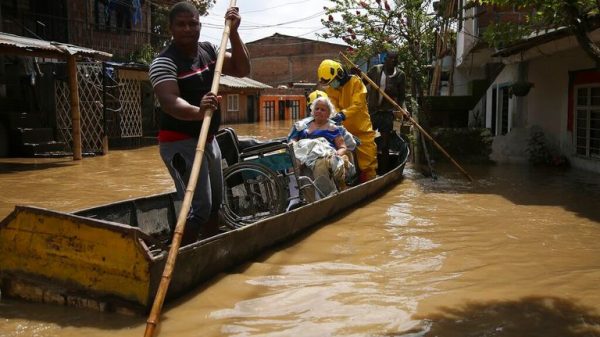Israel launched an intense barrage of airstrikes across swathes of Lebanon on Monday in what was the deadliest day for the country since at least the 2006 war fought between Israel and the powerful Iran-backed militant group Hezbollah.
Terror and despair gripped Lebanese residents as Israeli bombs killed at least 492 people, including dozens of children and wounded more than 1,600 others, authorities said, as residents fled their homes desperate to reach safety.
Israeli Prime Minister Benjamin Netanyahu said his country is changing the “balance of power” on its northern front as its military said it struck 1,600 Hezbollah assets across Lebanon on Monday and has not ruled out the possibility of a ground invasion.
Several countries have warned the strikes increase the risk of a wider regional war and have called for urgent international pressure to de-escalate the situation. Despite the scale and intensity of Monday’s strikes, neither side is calling the current escalation a war.
Here’s what we know.
What happened?
On Monday, Israel intensified its air campaign on Hezbollah, launching “extensive strikes” targeting the Iran-backed militant group in Lebanon. It marked the deadliest day of Israeli strikes in Lebanon since the 2006 war and hit multiple parts of the country, mainly in the southern and eastern parts of the country near Lebanon’s border with Syria and where the militant group has a strong presence.
Women, children and medics were among those killed and wounded, Lebanon’s health ministry said Monday. It is unclear how many of the casualties were civilians or Hezbollah militants, but many of the locations described by Israel as Hezbollah targets are also residential neighborhoods and villages.
Isarel said that among the Hezbollah targets were “cruise missiles” that had a reach of hundreds of kilometers, rockets, and explosive warheads, according to military spokesperson Daniel Hagari, who claimed the munitions were stored in civilian homes.
Residents began to flee their homes after their phones began pinging with text messages from Israel and calls from unknown numbers urging them to evacuate immediately. A popular Lebanese radio station said it was hacked and its broadcast interrupted by an Israeli evacuation warning. The Israeli military warned civilians to leave areas in which Hezbollah operates, such as those used to store weapons.
Residents said they had little time to flee to safety before the bombing started. One resident in the southern city of Tyre on the coast of Lebanon said he heard Israeli warplanes “raining” bombs near his home from 5 a.m. local time on Monday.
Classes in schools and universities were canceled across the country and some flights to and from Beirut were suspended. Many schools were closed to be used as shelters for those seeking refuge.
On Tuesday, Hezbollah said it fired multiple rocket barrages into northern Israel, targeting the Ramat David airbase, Meggido airfield, and the Amos base, all located in the vicinity of the town of Afula in northern Israel.
Were civilians targeted?
Israel said it was targeting Hezbollah infrastructure, but video shows destruction of residential areas and the large death toll reflects the scale and intensity of the strikes.
The nearly 500 killed on Monday alone is roughly half the number of Lebanese killed throughout the entire 34-day war between Israel and Hezbollah in 2006.
Israeli warplanes were also seen flying over different parts of the country late afternoon, including over Mount Lebanon where Hezbollah does not have a notable presence.
Lebanon’s representative to the United Nations General Assembly said there was a mass “exodus” of people fleeing. One Lebanese NGO said more than 100,000 people had been displaced.
Residents described seeing buildings collapse and towns being emptied, while images and video show roads blocked by heavy traffic in both directions as people try to flee. Reuters video from the southern suburbs of Beirut showed debris from damaged buildings and shards of glass littering the ground.
“We have nowhere to go, we have nothing, Mohamed Hamayda, a Syrian man displaced from Deir al-Zahrani, told Agence France-Presse news agency.
Lebanon’s Health Minister Dr. Firass Abiad said convoys of vehicles evacuating people from areas under fire had been “targeted,” as had two ambulances, a fire truck and a medical center. Two first responders were killed, he added.
The Israeli military said it was trying to “mitigate the harm to Lebanese civilians as much as possible,” Hagari said. Netanyahu accused Hezbollah of long using civilians as human shields while aiming rockets at Israeli citizens.
Why is Israel attacking Lebanon?
Hezbollah and Israel have been in conflict for decades – but the two have ramped up their cross-border attacks on each other since last October, when Israel’s war in Gaza began following the Palestinian militant group Hamas’ deadly October 7 attack on Israel.
Hezbollah is part of a Tehran-led alliance spanning Yemen, Syria, Gaza, and Iraq that has attacked Israel and its allies since the war with Hamas began. The group has said it will continue striking Israeli targets as long as the war in Gaza goes on.
The increasing escalations have once again brought the region to the edge of an all-out war.
Last week, Hezbollah – one of the most powerful paramilitary forces in the region – was left reeling after a deadly twin attack by Israel, when pagers and walkie-talkies used by Hezbollah members simultaneously exploded across the country. The attack was followed by an Israeli strike on a building in a densely populated southern Beirut, which killed at least 45 people including a top commander and other senior operatives, as well as women and children.
The following days saw some of the most intense exchanges of fire between Israel and Hezbollah in almost a year of war in Gaza, as the Lebanese militant group fired projectiles deeper into Israeli territory than has previously been seen and Israel fired hundreds of projectiles into southern Lebanon.
It came as Israel made a new war objective to return diplaced residents to their homes near the northern border after being evacuated due to Hezbollah attacks.
Though weakened militarily and its secretive lines of communication exposed, Hezbollah’s second-in-command has declared “a new chapter” in the confrontations which he called “a battle without limits.”
Is Lebanon and Israel at war?
While the airstrikes, attacks and rhetoric from both Israel and Hezbollah suggest they are in open conflict, neither side is calling the current escalation a war.
The head of Israel’s military Herzi Halevi said it is “preparing for the next phases” and Netanyahu in a televised speech told the people of Lebanon that his country is not at war with them, but with Hezbollah.
There is a renewed effort from the international community to de-escalate the situation. Qatar, one of the key mediators in talks between Israel and Hamas, said the region is on the “brink of the abyss” and France has requested an emergency meeting of the UN Security Council to address the strikes.
World leaders will be gathering in New York for the UN General Assembly this week and there are feverish efforts behind the scenes to convince Israel not to escalate further and launch a ground incursion into Lebanon.
Though the United States is Israel’s closest ally and biggest weapons supplier, a senior State Department official said the US and its partners are attempting to find a diplomatic solution.



























